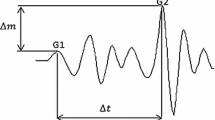Abstract
The probabilistic neural network (PNN) model is developed based on Bayesian criteria of multivariate pattern classification. Because PNN has the advantages of low training complexity, high stability, quick convergence, and simple construction, it can be well applied in the area of defect recognition. The application of PNN has a bottleneck problem; that is, the selection of smoothing parameters will seriously affect PNN recognition accuracy. In this paper, we propose an improved PNN model that employs a differential evolution algorithm to optimize the smoothing parameters. Furthermore, a defect recognition approach is proposed based on the improved PNN, which is successfully applied to an anchoring testing field. The proposed approach includes two key steps. The first step involves extracting the energy eigenvector of the defect signal with normalization based on a wavelet packet. The second step involves recognizing defects based on the improved PNN. Simulation results show that our improved PNN model is superior to the traditional PNN model. Thus, the improved PNN can provide useful references for recognizing the defect type of rock bolts in engineering.










Similar content being viewed by others
References
Yan SL, Qin Y, Chi XW (2009) Analysis on non-destructive detection of rock bolt at underground powerhouse of BaiSe water conservancy project. J Wuhan Univ Technol 31(2):129–132
Zhou Y, Li Z, Liang GQ (2012) Nondestructive technique for qualities of roof bolt sand anchors in tunnel. NDT 34(12):69–76
Liao L, Zhang CS, Liu M (2013) Discussion on 20–1000 kHz ultrasonic guided wave in the anchoring quality inspection. Metal Mine 11:119–122
Pan LY, Zhang CS, Ma JT, Wang YT, Liu M (2014) Analysis on effective anchoring bolt length detected with high frequency ultrasonic guided wave. Coal Sci Technol 42(12):24–26
Ivanovic A, Neilson RD (2008) Influence of geometry and material properties on the axial vibration of a rock bolt. Int J Rock Mech Min Sci 45(6):941–951
Sun YX, He CF, Wu B, Wang XY, Liu ZH (2008) Research of ultrasonic guided wave technology in steel rock bolt detection. Geotech Invest Surv 4:68–71
Krishnasamy U, Nanjundappan D (2015) Hybrid weighted probabilistic neural network and biogeography based optimization for dynamic economic dispatch of integrated multiple-fuel and wind power plants. Int J Electr Power Energy Syst 77:385–394
Zhang YD, Wu LN, Neggaz N (2009) Remote-sensing image classification based on an improved probabilistic neural network. Sensors 9(9):7516–7539
Gao J (2007) Artificial neural network principle and simulation examples, vol 1. China Machine Press, Beijing, pp 6–19
Boonnak N, Kamonsantiroj S, Pipanmaekaporn L (2015) Wavelet transform enhancement for drowsiness classification in EEG records using energy coefficient distribution and neural network. Int J Mach Learn Comput 5:288–293
Chacko BP, Krishnan VRV, Raju G, Babu Anto P (2015) Handwritten character recognition using wavelet energy and extreme learning machine. Int J Mach Learn Cybernet 3(2):149–161
Yang JG (2005) Wavelet analysis and application. China Machine Press, Beijing 4
Wang X-Z, Aamir R, Ai-Min F (2015) Fuzziness based sample categorization for classifier performance improvement. J Intell Fuzzy Syst 29:1185–1196
Wang R, Kwon S, Wang X-Z, Jiang Q-S (2015) Segment based decision tree induction with continuous valued attributes. IEEE Trans Cybern 45(7):1262–1275
Wang X-Z, Xing H-J, Li Y et al (2015) A study on relationship between generalization abilities and fuzziness of base classifiers in ensemble learning. IEEE Trans Fuzzy Syst 23(5):1638–1654
Wang X-Z (2015) Uncertainty in learning from big data-editorial. J Intell Fuzzy Syst 28(5):2329–2330
Shuxia L, Wang X, Zhanga G, Zhoua X (2015) Effective algorithms of the Moore-Penrose inverse matrices for extreme learning machine. Intell Data Anal 19(4):743–760
Wang X, Hong J-R (1998) On the handling of fuzziness for continuous-valued attributes in decision tree generation. Fuzzy Sets Syst 99(3):283–290
Yang L, Ren CM, Zhou T (2005) Research on random pattern classifier based on Parzen window method. He’nan Sci 23:97–99
Su L (2012) Fatigue life classification and prediction of welding. Chang’an University, Xi’an
Long W (2008) Study of identification for chinese whispered speech based on probabilistic neural network. Suzhou University, Suzhou
Storn R, Price K (1997) Differential evolution—a simple and efficient heuristic for global optimization over continuous spaces. J Global Optim 11:341–359
Heng LY, Dai P, Fu X (2010) Rotor bar breaking fault diagnosis for motor based on wavelet packet frequency band-energy reconstruction. Electric Mach Control 37:56–60
Chandwadkar DM, Sutaone MS (2013) Selecting proper features and classifiers for accurate identification of musical instruments. Int J Mach Learn Comput 3:12–175
Bendjama H, Bouhouche S, Boucherit MS (2012) Application of wavelet transform for fault diagnosis in rotating machinery. Int J Mach Learn Comput 2:82–87
Acknowledgments
This work was supported by the National Natural Science Foundation of China (Grant Nos. 51274144, 51307112, 51574250) and the Natural Science Foundation of Hebei Province of China (Grant No. E2014210075).
Author information
Authors and Affiliations
Corresponding author
Rights and permissions
About this article
Cite this article
Sun, Xy., Kang, Fn., Wang, Mm. et al. Improved probabilistic neural network PNN and its application to defect recognition in rock bolts. Int. J. Mach. Learn. & Cyber. 7, 909–919 (2016). https://doi.org/10.1007/s13042-016-0506-2
Received:
Accepted:
Published:
Issue Date:
DOI: https://doi.org/10.1007/s13042-016-0506-2




